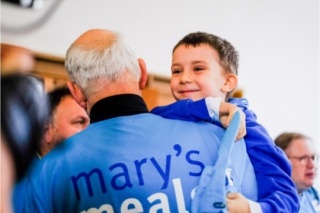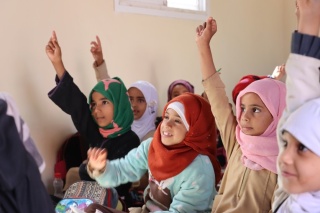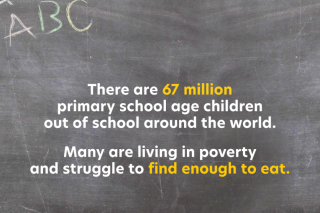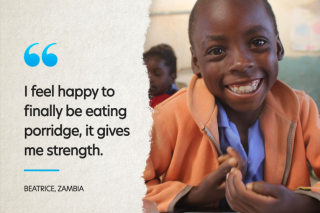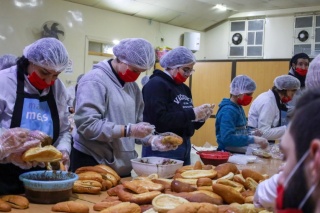
Zero Hunger: how it happened
Visions of a future free from child hunger and poverty.
One day, I hope not too long from now, a child will read in a history book about famines of the past and the fact that millions of people used to die of hunger year after year, in a world of plenty. And like us when we first read about slavery, or the Holocaust, they will be outraged and incredulous. And they will ask questions: How could those civilisations that put people on the moon and invented computers not have solved this problem? How could a global community that produced more than enough food for everyone have possibly allowed that to happen? It’s not like they were waiting to discover a cure for hunger. Did they just not care?
And then they will read the inspiring part. All about the generation that at long last did defeat hunger – at least the sort that kills people – once and for all. They will learn about a movement that played a crucial part in ending child hunger by ensuring that every child in this world had the opportunity to eat a daily meal in a place of education. For, how can any part of the human family make progress if its children are without adequate food and access to at least a basic education?
This is not wishful thinking. Based on what it is costing us today to provide 2.4 million of the world’s poorest children in 18 countries with a daily meal in their place of education, we can roughly work out the total amount required to serve all of the children in the world who are in most acute need of school meals. It’s estimated that there are 140 million children who find themselves in this position and nearly half are not even enrolled in school.
Any calculation of this ‘global cost of daily school meals’ for the most vulnerable children can only be a broad-brush estimation but, even still, it’s one that immediately throws up some thought-provoking and uncomfortable comparisons.
For example, the amount we spend on our pets each year, in the UK alone, is far more than the figure required globally to ensure each child can eat every day at school. The same goes for what is spent annually on purchasing luxury yachts in the USA. And there are many companies whose global profits could cover the amount required many times over.
I do not mention these facts to make anyone feel guilty. I, for one, intend to keep giving our beloved collie dog, Moy, the food she needs to keep bouncing about each day. My intention is only to challenge a commonly held myth that child hunger is inevitable – that the scale of the problem is too enormous to solve. It very clearly isn’t. As a global community and as individuals we make our choices and set our priorities. The fact that those millions of impoverished children are suffering without school meals today is a result of those choices, rather than some unsolvable problem beyond our control. We are not waiting to discover a magic cure for child hunger.
Thankfully, many individuals are making a choice to do something about this problem. Among them, a movement of people is working together to ensure that more than 2.4 million children receive nutritious daily meals each day in their place of education. This movement is Mary’s Meals, and most of the people involved are less interested in large numbers, choosing instead to focus on some very small ones:
10 pence; 11 cents (Euros); 13 cents (USD) – the average cost to provide one of our meals. £19.15; €22.00; $25.20 – the cost to provide a child with these meals for an entire school year.
These numbers tell us we can all do something. Instead of simply shaking our heads and pointing the finger at governments and multinational companies – and the owners of bouncy collie dogs – we can choose to take action ourselves and do something ‘small’ … like the young people who attend the Two Hills Mennonite School in Canada. Each Valentine’s Day they stage a ‘Candygram’ fundraiser in aid of Mary’s Meals, selling bundles of candy (sweets) to each other to raise money to feed more children. One of their teachers explained:
“My students have expressed that they have been blessed with so much while others have so little, so they want to help. They love Mary's Meals because they see that small gestures on their part quickly add up and make a big difference to a child.”
Meanwhile, Lucia Höfer recently dedicated her 18th birthday celebrations to our work by cycling from Düsseldorf to Mannheim in five days and in doing so raised enough funds to provide meals for 626 children for an entire school year. And Barborka, a young girl with Down Syndrome in Slovakia, paints pictures to sell and raise money for Mary’s Meals. Since 2020, she has ensured that 1,400 children can receive life-changing meals for a whole school year by selling her artwork and donating the proceeds.
Barborka’s mother told us: “We were intrigued by the fact that just a little is enough to save the lives of children in the poorest countries.” And all over the world, people – very often young people – are being intrigued and inspired in the same way.
And then there is the multitude of people in this movement who do not ever raise funds or donate money but nevertheless make an invaluable contribution. Each day, tens of thousands of volunteers – who live in the impoverished communities in which the meals are served – give up their time to cook and serve the food (which is, wherever possible, sourced locally to support producers and the local economy). Their contribution – which is ever more heroic given the daily struggles many of them face – is at the heart of this powerful movement and its irresistible momentum.
“Volunteering is important to me. I feel happy when I see that children are happy, healthy and attend school without fail because of the meal served,” says Maureen who has been volunteering to serve meals at her local school in Kenya since 2018. “I play a very important role in shaping the destiny of these children because the meal provided in school will enable them to complete their education and become independent in future.”
And that is the dream of all those who are joining the Mary’s Meals movement – a future that sees children and communities, equipped with an education, set free from poverty and dependence on aid. But this isn’t just a dream for the future. The life-changing reality of daily meals in school is already transforming some of the poorest, most vulnerable communities on earth. The Mary’s Meals movement grows because the suffering of hungry children cries out today – as does the possibility for each of us to help serve them tomorrow.
I hope that the actions of all these individuals around the world might become an early chapter in the story those children will one day read in their history books – a story that goes way beyond one organisation called Mary’s Meals – a story that might be called ‘Zero Hunger: how it happened.'
